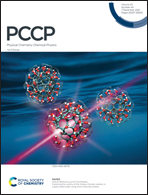Intrinsic-to-extrinsic emission tuning in luminescent Cu nanoclusters by in situ ligand engineering†
Abstract
Enhancement of the emission quantum yield and expansion of the emission tunability spectrum are the key aspects of an emitter, which direct the evolution of future generation light harvesting materials. In this regard, small molecular ligand-protected Cu nanoclusters (SLCuNCs) have emerged as prospective candidates. Herein, we report the broadband emission tunability in a SLCuNC system, mediated by in situ ligand replacement. 1,6-Hexanedithiol-protected blue emissive discrete Cu nanoclusters (CuNCs) and red emissive CuNC assemblies have been synthesized in one pot. The red emissive CuNC assemblies were characterized and found to be covalently-linked nanocluster superstructures. The blue emissive CuNC was further converted to a green-yellow emissive CuNC over time by a ligand replacement process, which was mediated by the oxidized form of the reducing agent used for synthesizing the blue emissive nanocluster. Steady-state emission results and fluorescence dynamics studies were used to elucidate that the ligand replacement process not only modulates the emission color but also alters the nature of emission from metal-centered intrinsic to ligand-centered extrinsic emission. Moreover, time-dependent blue to green-yellow emission tunability was demonstrated under optimized reaction conditions.



 Please wait while we load your content...
Please wait while we load your content...